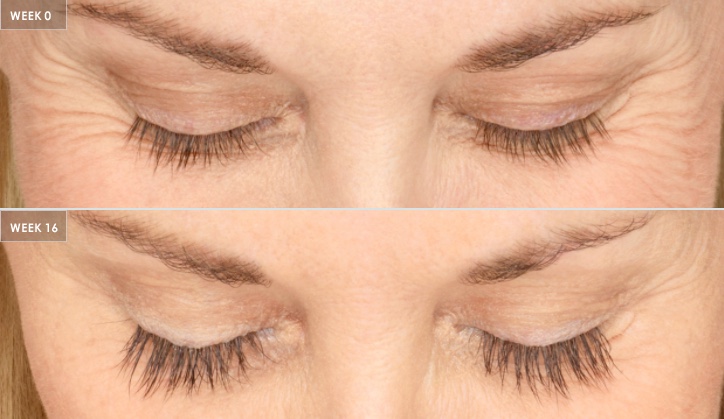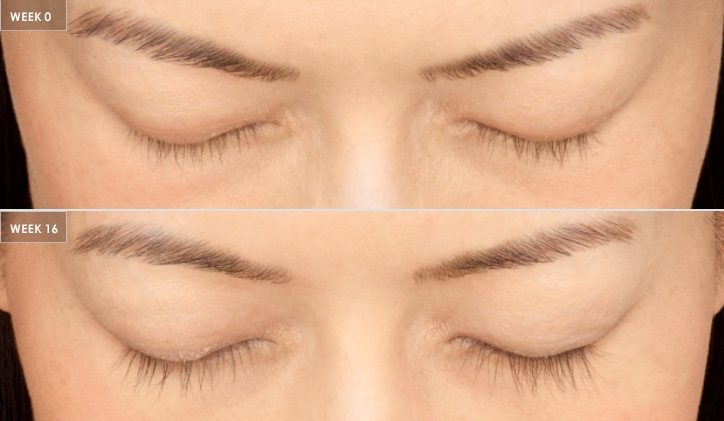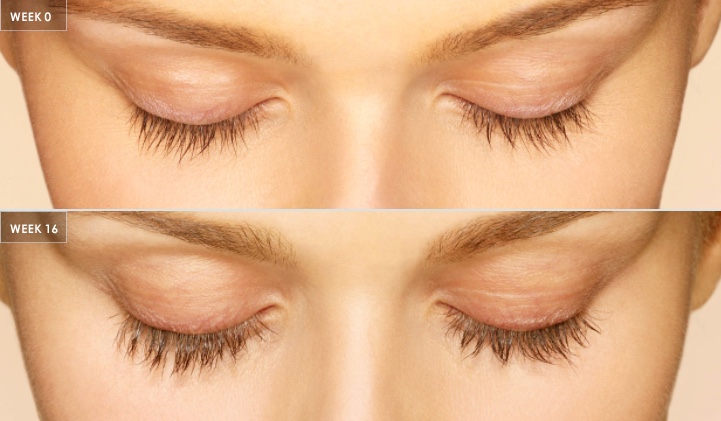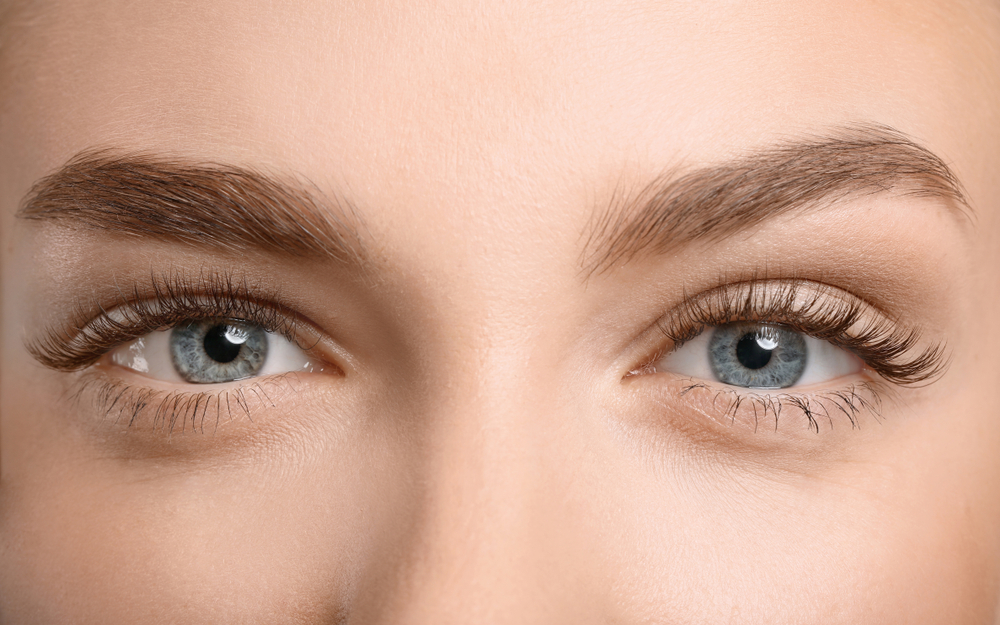- Latisse is an FDA-approved medication that can make eyelashes longer, thicker, and darker.
- It takes 16 weeks of regular use to achieve the full results.
- Latisse is generally safe to use, but may cause some non-serious side effects.
- Latisse is only available with a doctor’s prescription.
If you are unsatisfied with the way your eyelashes look, you are not alone. For a long time, people have been using makeup, vaseline, various oils, and natural remedies in an attempt to get those perfect-looking lashes. But now, a more effective method is available.
What is Latisse?
Manufactured by Allergan, Latisse contains the active ingredient Bimatoprost, a compound similar to prostaglandins that are naturally found in the body.
Bimatoprost was originally developed for the treatment of glaucoma (elevated pressure inside the eyeball). During trials and real-life use, patients undergoing this treatment noticed that their eyelashes had gotten longer, thicker, and darker.
A clinical trial was then conducted to evaluate this observation. Upon its successful conclusion, Latisse was approved by the Food and Drug Administration (FDA) as a cosmetic topical solution for the enhancement of eyelashes.
Several other studies have since been conducted, and have all reached similar conclusions. In short, Latisse works.



How does Latisse work?
Every hair in your body—including eyelashes—goes through four phases during its life. The first of these phases, the anagen, is considered the active growth stage, and should last between one and two months for eyelashes.
The final length, thickness, and overall health of the eyelash are directly related to the amount of time it spends in anagen before moving on to the next phase. Latisse lengthens the anagen phase for each eyelash, and increases the number of hairs in anagen at any one time.
Latisse is also thought to increase the size of the eyelash root and stimulate the pigment-producing process. This results in thicker, darker eyelashes.
How is Latisse applied?
For the best results, Latisse should be used once each night. Follow these instructions for proper application:
- Before applying Latisse, gently clean your face and remove all makeup. Contact lenses should be removed.
- Pull out a single applicator from the package, making sure not to touch the tip.
- Holding the applicator horizontally, gently squeeze the dropper to place a single drop of the solution on the brush part of the applicator.
- Carefully draw the applicator across your upper eyelid margin (where the upper eyelash roots meet the skin of the eyelid). Start at the inner part of your lash line and move towards the outer part. Do not apply to the lower lid or into the eye.
- Blot any excess solution with a clean tissue.
- Discard the applicator.
- Repeat steps 2 through 6 for the other eyelid, using a new sterile applicator.
How long does it take to work?
You may begin to see results in as little as four weeks after starting treatment. However, it takes 16 weeks of continued use to achieve the full effects of Latisse.
Even if you are happy with the results after eight or ten weeks, you should still complete the full course. This will allow your lashes to grow more and survive longer.
After completing the 16-week treatment period, discuss continued use with your doctor. He or she may recommend that you keep using Latisse a few times per week to sustain your improvements.
Are the results permanent?
Unfortunately, no. The effect of Latisse on lengthening the eyelash growth phase only persists as long as the medication is applied. After discontinuation, the lashes that grew under the influence of Latisse will eventually reach the end of their life. Your lashes will then gradually return to their original state.
It may take several months for your eyelashes to revert to their previous appearance. “After a typical 4 month consistent usage, if Latisse is discontinued the lash effects tend to last up to a year, but in my experience rarely longer than that,” says Purchase, NY ophthalmologist Dr. Anne Negrin.
In order to maintain the results achieved with Latisse, your doctor may recommend that you keep using it after completing the 16-week course, gradually tapering down the number of uses each week.
“I often recommend patients slowly taper the medication instead of stopping completely—usually to once a day for several months, then once every other day for at least a year,” says Dr. Negrin.
Do I need a prescription?
Yes. A licensed physician will need to perform a brief examination and review your medical history before writing you a prescription for Latisse.
How much does Latisse cost?
Latisse costs approximately $120 for a 3ml bottle with 30 pairs of applicators (one-month supply). A larger 5ml size is also available, and costs about $180.
There is some variability in price depending on where you buy it; some doctors we spoke with mentioned prices as low as $120 for a 2-month supply. You can also ask if any rebates are available.
What are the possible side effects of Latisse?
Relatively common side effects associated with Latisse include eye redness, itching, and irritation. These were experienced by approximately 4% of subjects in a clinical study of Bimatoprost published by the Journal of the American Academy of Dermatology.
“In terms of side effects, most people experience lash elongation and no adverse effects,” says Dr. Rhonda Klein of Connecticut Dermatology Group.
Other less common side effects may include allergic reactions, dry eyes, eyelid skin darkening, darkening of the iris (the colored part of the eye), and unintended hair growth in areas frequently coming in contact with the medication.
According to Dr. Klein, a more serious adverse event is a condition called prostaglandin-associated periorbitopathy (PAP)—a constellation of symptoms that includes periorbital (around the eyes) fat loss, sunken eyes, and laxity of the eyelid skin. However, this condition is more common with Bimatoprost glaucoma eye drops, and should resolve with cessation of treatment.
Will Latisse change the color of my eyes?
While this is possible, it is relatively rare. A brown pigmentation of the iris has been more frequently documented in patients using Bimatoprost glaucoma eye drops. Proper application of Latisse should prevent the occurrence of this side effect.
Can I use Latisse on my eyebrows, head, or beard?
There is no scientific evidence that supports the use of Latisse in growing eyebrow, head, or beard hair. Although some anecdotal success stories of people using it off-label on their eyebrows exist, there is not enough proof for doctors to recommend it.
It is important to note that Latisse works by making the hair you do have longer—it does not grow entirely new hair follicles. Therefore, Latisse is unlikely to be proven useful in the treatment of male pattern baldness, bald spots, or any other conditions where hair follicles simply do not exist.
Can I use Latisse if I have glaucoma?
It depends. Combining Latisse with glaucoma medications, particularly Bimatoprost eye drops, may yield unpredictable results on eye pressure.
Generally speaking, people who have glaucoma should not use Latisse. However, pending close monitoring, and depending on what type of glaucoma medication you are taking, your physician may prescribe you Latisse.
Is Latisse safe during pregnancy?
It is not clear whether Latisse is safe to use during pregnancy or lactation. According to the FDA, Latisse has caused some harmful effects in pregnant animal studies, but has not been adequately studied in humans. For this reason it has been designated Category C.
Pregnancy Category C drugs may be given during pregnancy, but only if the benefits outweigh the risks. Since Latisse is used for purely cosmetic reasons, pregnant women should therefore avoid it.









